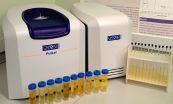Brain folding
Programs that control the production of neurons during brain development determine how the brain folds
2014-12-01
(Press-News.org) This news release is available in German.
The neocortex is the part of the brain that enables us to speak, dream, or think. The underlying mechanism that led to the expansion of this brain region during evolution, however, is not yet understood. A research team headed by Wieland Huttner, director at the Max Planck Institute of Molecular Cell Biology and Genetics, now reports an important finding that paves the way for further research on brain evolution: The researchers analyzed the gyrencephaly index, indicating the degree of cortical folding, of 100 mammalian brains and identified a threshold value that separates mammalian species into two distinct groups: Those above the threshold have highly folded brains, whereas those below it have only slightly folded or unfolded brains. The research team also found that differences in cortical folding did not evolve linearly across species.
The Dresden researchers examined brain sections from more than 100 different mammalian species with regard to the gyrencephaly index, which indicates the degree of folding of the neocortex. The data indicate that a highly folded neocortex is ancestral - the first mammals that appeared more than 200 million years ago had folded brains. Like brain size, the folding of the brain, too, has increased and decreased along the various mammalian lineages. Life-history traits seem to influence this: For instance, mammals with slightly folded or unfolded brains live in rather small social groups in narrow habitats, whereas those with highly folded brains form rather large social groups spreading across wide habitats.
A threshold value of the folding index at 1.5 separates mammalian species into two distinct groups: Dolphins and foxes, for example, are above this threshold value - their brains are highly folded and consist of several billion neurons. This is so because basal progenitors capable of symmetric proliferative divisions are present in the neurogenic program of these animals. In contrast, basal progenitors in mice and manatees lack this proliferative capacity and thus produce less neurons and less folded or unfolded brains.
Duration and speed of brain development
The highly folded brains of mammals not only contain more neurons, they also grow with greater speed: The brain weight accumulated per gestational day is 14 times greater in species with a high degree of cortical folding. The differences among species between the two groups separated by the threshold value can be explained by longer neurogenic periods rather than different neurogenic programs. The neurogenic period of a human fetus is eight to nine days longer than that of apes. This leads to a brain three times larger than that of a chimpanzee - a fundamental difference that contributes to what makes us human.
INFORMATION:
Eric Lewitus, Iva Kelava, Alex T. Kalinka, Pavel Tomancak, Wieland B. Huttner
An Adaptive Threshold in Mammalian Neocortical Evolution
PLOS Biology, 18 November 2014 (doi: 10.1371/journal.pbio.1002000)
ELSE PRESS RELEASES FROM THIS DATE:
2014-12-01
When it comes to logging, it may be possible to have our timber and our tropical forests, too. The key, according to a report in the Cell Press journal Current Biology on December 1, is careful planning and the use of reduced-impact logging (RIL) practices that avoid unnecessary damage to the surrounding forest.
"Four million square kilometres of tropical forest are designated for logging globally," says Jake Bicknell of the University of Kent in the United Kingdom, noting that this represents an area larger than the size of India. "Even if we could improve timber harvesting ...
2014-12-01
Researchers have identified the cause for a disorder common in Inuit people that prevents the absorption of sucrose, causing gastrointestinal distress and failure to thrive in infants. The study, published in CMAJ (Canadian Medical Association Journal), identified a genetic mutation responsible for the disorder, called congenital sucrose-isomaltase deficiency (CSID).
CSID is a rare disorder in people of European descent, but is more common in Inuit people living in northern Canada, Greenland and Alaska, with rates estimated between 5% and 10%. The disorder prevents the ...
2014-12-01
In recent years, cilia, microscopic, tentacle-like extensions from biological cells, have risen from relative obscurity and are now considered important to the understanding of many human afflictions. In a December BioScience article, George B. Witman, of the University of Massachusetts Medical School, and Jason M. Brown, of Salem State University, describe recent discoveries involving cilia-related diseases (called "ciliopathies") and highlight "model" species that could be useful for systematic study of ciliopathies.
Cilia perform a broad range of functions, including ...
2014-12-01
Tropical Storm Sinlaku made landfall in east-central Vietnam bringing some moderate to heavy rainfall with it. NASA and the Japan Aerospace Exploration Agency's TRMM and GPM satellites analyzed the rainfall rates occurring in Sinlaku before it made landfall while NASA's Terra satellite spotted the storm as it came ashore in Vietnam.
Tropical Storm Sinlaku formed on November 26, 2014 over the southeastern Philippines. As a tropical depression Sinlaku caused flooding in areas of the Visayas and Mindanao. The storm then moved west and crossed the South China Sea where it ...
2014-12-01
Scientists at the Institute of Food Research on the Norwich Research Park have teamed up with Oxford Instruments to develop a fast, cheap alternative to DNA testing as a means of distinguishing horse meat from beef. Because horses and cattle have different digestive systems, the fat components of the two meats have different fatty acid compositions, as the team report in the journal 'Food Chemistry'. The new method looks at differences in the chemical composition of the fat in the meats, using similar technology to a hospital MRI scanner.
In just ten minutes, a technician ...
2014-12-01
December 1, 2014 - The health departments of the nation's largest cities play a central role in developing innovative population health strategies for improving public health across the United States, according to a special January issue of the Journal of Public Health Management and Practice. The journal is published by Lippincott Williams & Wilkins, a part of Wolters Kluwer Health.
"Indeed, cities are at the forefront in extending public health and social policy to realize changes in our environment abetting population health," according to a commentary by Lloyd F. ...
2014-12-01
ROSEMONT, Ill.--Prompt and appropriate treatment of a dislocated shoulder--when the head of the upper arm bone (humerus) is completely knocked out of the shoulder socket (glenoid)--can minimize risk for future dislocations as well as the effects of related bone, muscle and nerve injuries, according to a literature review appearing in the December issue of the Journal of the American Academy of Orthopaedic Surgeons (JAAOS).
The shoulder has the greatest range of motion of any joint in the human body and is the most common site for a full or partial dislocation. Shoulder ...
2014-12-01
This news release is available in German. Ideally, diamonds consist of pure carbon. But natural diamonds always contain defects. The most researched defects are nitrogen-vacancy centers comprising a nitrogen atom and a vacancy. These might serve as highly sensitive sensors or as register components for quantum computers. However, until now it has not been possible to extract the optically stored information electronically.
A team headed by Professor Alexander Holleitner, physicist at the TU München and Frank Koppens, physics professor at the Institut de Ciencies ...
2014-12-01
Conflicting evidence about the extent to which men's semen quality declines with age--likely lowering their fertility--is being cleared up by new University of Otago, New Zealand, research that has collated and reviewed data from 90 previous studies from around the world.
After conducting a systematic review and meta-analysis of the studies' data, researchers from the University's Departments of Zoology and Anatomy found consistent age-related declines in semen volume and sperm performance and increases in malformed and DNA-damaged sperm. Semen quality is regarded as ...
2014-12-01
Singapore--Scientists at A*STAR's Genome Institute of Singapore (GIS), in collaboration with local clinicians and colleagues in the USA, have identified a biomarker which is strongly associated with triple negative breast cancer (TNBC), a highly aggressive carcinoma that often has early relapse and metastasis following chemotherapy. The newly identified biomarker, a gene called RASAL2, provides a target for developing new therapeutics designed to treat this often deadly disease.
TNBC is deadly because, unlike other types of breast cancers such as estrogen receptor (ER) ...
LAST 30 PRESS RELEASES:
[Press-News.org] Brain folding
Programs that control the production of neurons during brain development determine how the brain folds



